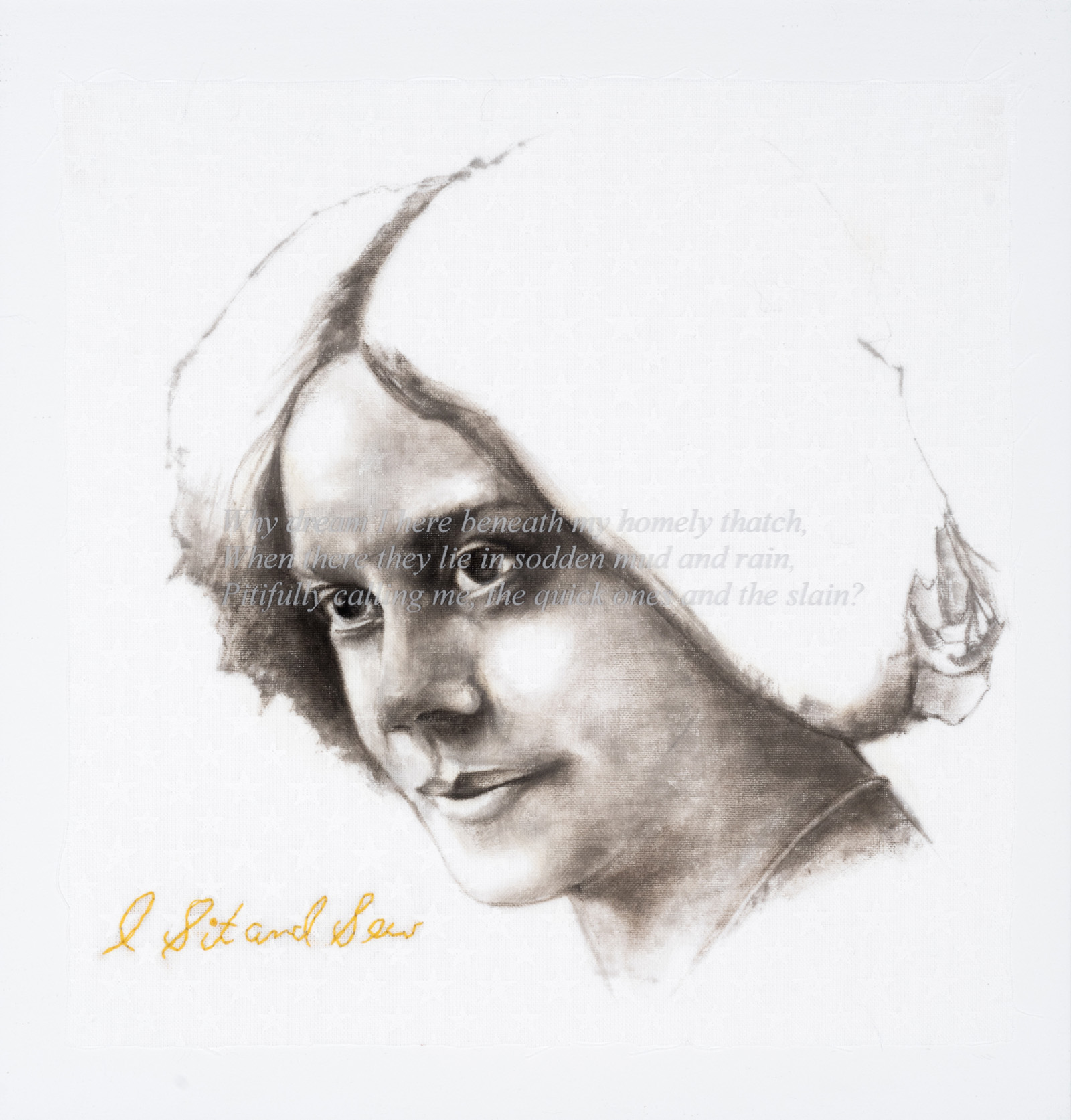












Delaware Art Museum
For this most recent Delaware Art Museum commission, Charles Edward Williams commemorated the life of Alice Dunbar-Nelson, the poet and political activist who spent most of her career writing and lecturing in Wilmington. The works of art are displayed alongside historical portraits in the Museum’s early American galleries. An intervention of sorts into this gallery space, Williams’ exhibition honors the life of this important literary figure as her image joins the faces of others in the room.
Artist Charles Edwards Williams’ recent projects draw on historical photography of the Civil Rights Movement. Pairing vibrant colors with distinct portraits, Williams establishes an emotional connection between the image and the viewer. When exploring Alice Dunbar-Nelson’s life, Williams began by surveying Dunbar-Nelson’s diaries, photographs, and published works.
Alice Dunbar-Nelson’s life spanned many significant historical events. She was born in New Orleans just ten years after Union troops arrived in Texas on June 19, 1865 to declare the freedom of enslaved Black people in that state, a date we now mark as Juneteenth. She witnessed the ratification of the women’s right to vote in 1920, as well as World War I, and the Great Depression. Throughout her poetry and personal writing, Dunbar-Nelson reflected on these, and many other, key social and cultural moments. Williams was drawn to Dunbar-Nelson’s frustration with the hindrances of a male-dominated world and her determination to actively respond to the first World War. His multimedia work, I Sit and Sew, explores this tension. Referencing Dunbar-Nelson’s 1918 poem of the same name, Williams’ seven-panel piece layers the etched lines of her poem over paintings of her image. Across the star-patterned linen support, Williams has stitched the words, I Sit and Sew. The artist used the physical act of sewing as an interpretation of Dunbar-Nelson’s poem and her desire to aid in the war efforts. She writes,
My soul in pity flings
Appealing cries, yearning only to go
There in that holocaust of hell, those fields of woe—
But—I must sit and sew.
(Dunbar-Nelson, 11-14).
When faced with this inner conflict, both writer and artist chose a seemingly tedious task that has historically been considered women’s work. Interestingly, embroidery was used as a form of therapy for soldiers wounded during World War I. Williams describes the meditative work as “spiritual, reflective, and transformative.” With each stitch, progress is made.
In Wish You Were Here, Williams follows Dunbar-Nelson’s travels and leisure time fishing along the banks of the Mississippi, Platt, Mystic, and Potomac Rivers. The artist’s paintings of her are less formal, more intimate, and over them Williams used fishing line to trace the shape of the rivers. In this way, Williams makes the literary giant approachable.
Williams’ I AM (Queen), is the most formal portrait of Alice Dunbar-Nelson, and elements within the composition are layered with meaning. The treatment of her dress references her racial background growing up in a Creole community in Louisiana. Dunbar-Nelson’s mother was Black and her father was white, and the poet wrote about her experience navigating two racial identities. The transition from the darker to lighter fabric across her shoulders indicates the barriers she felt connecting to both races.
Author: Margaret Winslow
Artist Charles Edwards Williams’ recent projects draw on historical photography of the Civil Rights Movement. Pairing vibrant colors with distinct portraits, Williams establishes an emotional connection between the image and the viewer. When exploring Alice Dunbar-Nelson’s life, Williams began by surveying Dunbar-Nelson’s diaries, photographs, and published works.
Alice Dunbar-Nelson’s life spanned many significant historical events. She was born in New Orleans just ten years after Union troops arrived in Texas on June 19, 1865 to declare the freedom of enslaved Black people in that state, a date we now mark as Juneteenth. She witnessed the ratification of the women’s right to vote in 1920, as well as World War I, and the Great Depression. Throughout her poetry and personal writing, Dunbar-Nelson reflected on these, and many other, key social and cultural moments. Williams was drawn to Dunbar-Nelson’s frustration with the hindrances of a male-dominated world and her determination to actively respond to the first World War. His multimedia work, I Sit and Sew, explores this tension. Referencing Dunbar-Nelson’s 1918 poem of the same name, Williams’ seven-panel piece layers the etched lines of her poem over paintings of her image. Across the star-patterned linen support, Williams has stitched the words, I Sit and Sew. The artist used the physical act of sewing as an interpretation of Dunbar-Nelson’s poem and her desire to aid in the war efforts. She writes,
My soul in pity flings
Appealing cries, yearning only to go
There in that holocaust of hell, those fields of woe—
But—I must sit and sew.
(Dunbar-Nelson, 11-14).
When faced with this inner conflict, both writer and artist chose a seemingly tedious task that has historically been considered women’s work. Interestingly, embroidery was used as a form of therapy for soldiers wounded during World War I. Williams describes the meditative work as “spiritual, reflective, and transformative.” With each stitch, progress is made.
In Wish You Were Here, Williams follows Dunbar-Nelson’s travels and leisure time fishing along the banks of the Mississippi, Platt, Mystic, and Potomac Rivers. The artist’s paintings of her are less formal, more intimate, and over them Williams used fishing line to trace the shape of the rivers. In this way, Williams makes the literary giant approachable.
Williams’ I AM (Queen), is the most formal portrait of Alice Dunbar-Nelson, and elements within the composition are layered with meaning. The treatment of her dress references her racial background growing up in a Creole community in Louisiana. Dunbar-Nelson’s mother was Black and her father was white, and the poet wrote about her experience navigating two racial identities. The transition from the darker to lighter fabric across her shoulders indicates the barriers she felt connecting to both races.
Author: Margaret Winslow